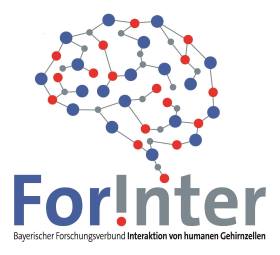ForInter
BAVARIAN RESEARCH ASSOCIATION INTERACTION OF HUMAN BRAIN CELLS

Neuron-microglia interaction: physiological and pathological signatures
Microglia are multifunctional glial cells in the central nervous system (CNS) parenchyma. They provide an important link between the nervous and immune systems and here within the adaptive immunity. They help to maintain physiological conditions through phagocytosis and secretion of cytokines. In addition, they contribute to neuronal plasticity by modulating the synapse formation and maintenance. Human brain microglia differ from rodent microglia in basic cellular and molecular characteristics. Furthermore, due to vast species dependent differences, we do not yet precisely understand how human microglia contribute to physiological development, as well as its precise role in disease progression.
We aim to generate human microglia-like cells from iPSCs and study specific signatures and their impact in microglia-neuron interactions. The aim of this project is to elucidate the underlying molecular and cellular mechanisms of human microglia and microglia-neuron interaction in 2D and 3D structures in the context of loss of CSF1R, resulting in hereditary diffuse leukoencephalopathy with spheroids (HDLS). For this purpose, co- cultures of iPSC-derived neurons and microglia are used. IPSCs are reprogrammed from a patient with HDLS and furthermore, an isogenic control is genome edited. In addition, a mutation in CSF1R in control IPSCs is generated by CRISPR/Cas9. This project will decipher the impact of CSF1R in human microglia and its interaction with forebrain neurons.
Project lead:
Prof. Dr. Beate Winner
Department of Stem cell Biology, Universitätsklinikum Erlangen
Project partners:
- Friedrich-Alexander-Universität Erlangen-Nürnberg



